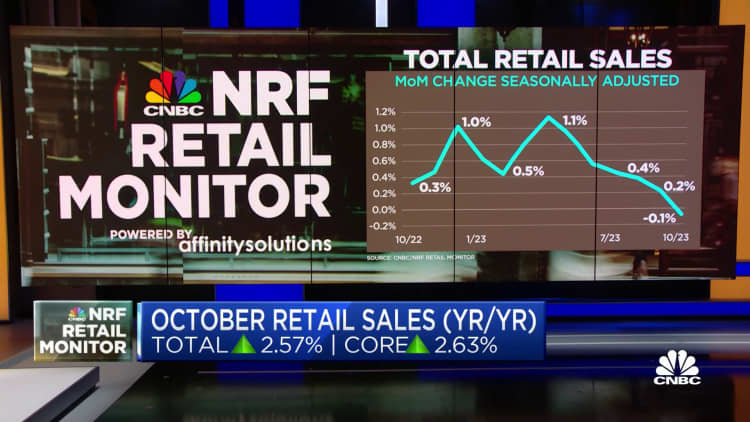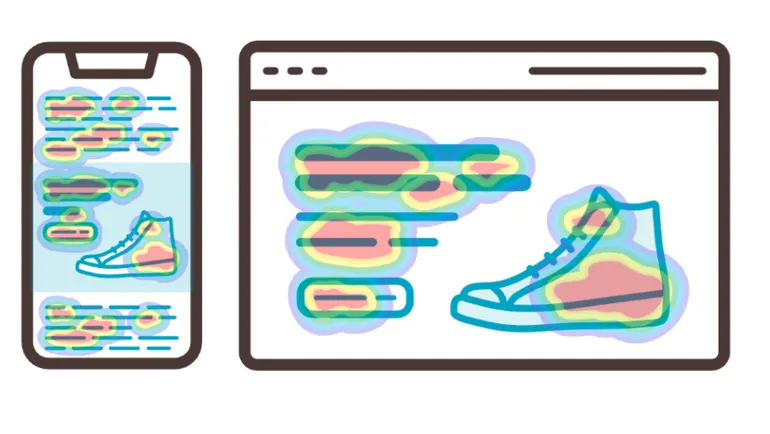Consumer spending fell in October, according to new CNBC/NRF Retail Monitor tracking card transactions
The new Retail Monitor, debuting Monday, is a joint product of CNBC and the National Retail Federation based on real card data from Affinity Solutions.


The consumer took a spending break ahead of the holiday season, with October retail sales, excluding autos and gas, falling by 0.08%, and core retail, which also removes restaurants, declining by 0.03%, according to the new CNBC/NRF Retail Monitor.
The new Retail Monitor, debuting Monday, is a joint product of CNBC and the National Retail Federation based on data from Affinity Solutions, a leading consumer purchase insights company. The data is sourced from more than 9 billion annual credit and debit card transactions collected and anonymized by Affinity and accounting for more than $500 billion in sales. The cards are issued by more than 1,400 financial institutions.
The data differs from the Census Bureau's retail sales report as it is the result of actual consumer purchases, while the Census relies on survey data. The government data is frequently revised as additional survey data becomes available. The CNBC/NRF Retail Monitor is not revised as it's calculated from actual transactions during the month. It is, however, seasonally adjusted, using the same program employed by Census.
"The CNBC/NRF Retail Monitor will modernize how retail sales are tracked and measured, and Affinity Solutions' vast dataset of how, what and where the consumer is spending will identify how key demographics and channels are performing for the industry generally and for specific retail sectors,'' said NRF President and CEO Matthew Shay.
"Our audience, investors and executives alike, will now be armed with dynamic insights that go beyond headline numbers to show emerging trends and critical detail," CNBC Senior Vice President of Business News Dan Colarusso said.
Weakness in electronics and furniture
The October data shows a cooling of consumer spending, in line with the consensus of Wall Street forecasts. Year over year, overall retail and core retail sales are both up 2.6%.
The October data showed weakness in gas station sales, electronics and appliances, and furniture and home stores. There was strength in sporting goods and hobby stores and nonstore retails, or internet sales, along with health and personal care.
Starting modestly before the Covid pandemic, and accelerating amid the outbreak, economists turned to real and high-frequency private sector data to gauge the economy. In some cases, it was due to the absence of government data, with some agencies unable to gather information and others finding response rates limited. In other cases, economists looked to data that was not readily available from government sources, like subway ridership data or how much consumer spending occurred "with card not present" to gauge whether Americans continued to shun shopping in person.
While the pandemic passed, the move toward actual, high-frequency and private sector data has continued to expand.
"The Retail Monitor heralds a new era of retail intelligence, where data isn't just a resource – it's a roadmap to understanding and engaging with the modern consumer," Affinity Solutions founder and CEO Jonathan Silver said. Affinity is also a leading provider of data to Wall Street.
In coming months, the Retail Monitor will provide demographic breakdowns of spending by age, income and geography.
Don't miss these stories from CNBC PRO:
75% of Warren Buffett's equity portfolio is in just 5 stocks. Here's what they areThese two banks just hiked their 1-year CD yield to 5.3%A prudent way to bet on a bounce in Apple following its post-earnings declineStifel says the S&P 500 will keep climbing 'wall of worry' to hit 4,400, gives 10 stocks to play rally
 ValVades
ValVades 
































